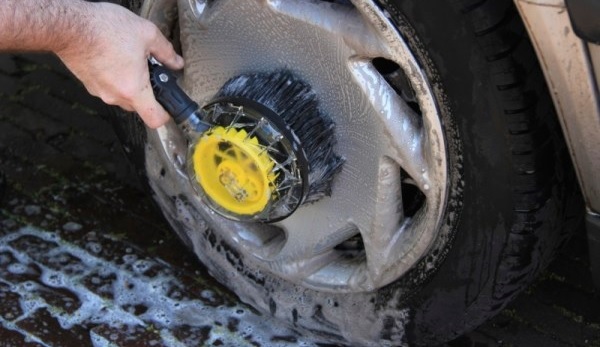While some cars still have a plastic wheel cover mounted over a black-painted steel wheel, even these vehicles have the option to upgrade to fancier products. Many people decide to go for the update and those wheels, like the rest of the car, get dirty and need cleaning.
Understanding brake dust
Make sure your customers are familiar with what exactly causes wheels to lose their shine. Dirt, dust, sand, bugs, road tar and salt all create filth on cars. To add to this a vehicle’s wheels are further affected by brake dust. This dust doesn’t travel far and mixes with other contaminants to sit right on the surface of the wheels.
Brake dust also consists of small metallic particles from the wear of pads and rotors. This composition is particularly harmful to the finish on alloy wheels, which may be painted, powder-coated or clear-coated. The longer it sits on these expensive rims, the greater likelihood that it will inflict permanent damage.
European cars seem to be more affected by brake dust, but American and Asian cars are not exempt. Most experts agree wheels caked with brake dust should be cleaned at least once a week to preserve their finish.
Washing with traditional carwash detergents and supplies will often not get the wheels as clean as your customers would like. Doing a thorough job does not necessarily mean spending huge amounts of money and time on the task.
For the purpose of this article, we will take a look at a simple four-step process to help bring the shine back to your customers’ wheels:
Blast the wheels with high-pressure water
Remember, clingy brake dust is not only on the outward-facing surface of the wheel. It’s also on the back of the wheel, tire, brake caliper and nearby suspension components.
Removing the wheel/tire combination for cleaning is not practical (unless you’re performing a weekend-long detail), so you need a way to reach all the dust you can’t see. High-pressure water, preferably from a pressure washer, will attack much of the dust.
Spray as much as you can through the wheel spokes, on the tire and around the wheel well opening. Even if you don’t have a pressure washer, a good, adjustable hose nozzle will help. Adjust the hose for maximum pressure. You want the wheel to be wet before moving on to step two.
Spray on a wheel-safe cleaning solution
When we think of unsightly brake dust, we’re usually picturing it on a once shiny and bright silver or chrome alloy wheel. However, vehicles with black-painted steel wheels and wheel covers still shed brake dust, even though it might not be as noticeable.
The finish on modern aluminium alloy wheels can be as delicate as a car’s painted finish. The last thing you want to do to a customer’s car (or your own) is to hit it with some harsh chemical which can damage the wheels’ finish.
The good news is that a huge variety of safe wheel cleaners are available on the market. They are designed for use on alloy wheels with delicate finishes, yet are strong enough to break down the brake dust.
The general instructions are as follows: First, wet the wheel; next, spray on the solution, and let it do its job, typically for one to three minutes (read the manufacturer’s label for specific instructions).
Agitate solution to reach all sides of the wheel
A carwasher’s or detailer’s best practice is to have the right tool for the job, as well as to have a dedicated tool for the job. You should always have products ready to most effectively and efficiently perform the task at hand. Your wheel cleaning arsenal should be comprised of brushes of various sizes and thicknesses, including some with extra long handles.
After applying the wheel solution, help it along by brushing the various wheel surfaces. Pay special attention to the sides of the wheel openings, where accumulation can be greater.
Wash cloths dedicated to wheel cleaning will do a better job on the flat external surfaces. Rinse and dry the wheel thoroughly, and rinse out the brushes and cloths at the same time.
Apply a protective wax coating to the wheel
Once the wheels are clean, you want to do everything you can to keep them clean. Your customers’ cars are going to be driven in all kinds of weather, and when the brakes are applied, brake dust will once again make an appearance. So how do you ensure customers’ wheels maintain cleanliness?
Just like paint, you can protect the wheels’ finish with a coat of wax. It will both maximize the gloss and protect the surface. When you apply a coat of wax, dirt and grease are less likely to adhere to the wheels.
Just like paint, you can protect the wheels’ finish with a coat of wax. It will both maximize the gloss and protect the surface. When you apply a coat of wax, dirt and grease are less likely to adhere to the wheels.
If you have the luxury of time, apply a standard wax — just like what you may use on paint — with a soft cloth. Allow the wax to dry, and then buff it out. This does make a difference.
‘Reduced dust’ brake pads
Whether you’re running an independent one-man detail shop, or a high-end automatic carwashing operation, your customers look to you to give them your professional automotive advice. If dirty wheels are an ongoing concern for your customers, don’t be shy about suggesting they consider a switch to brake pads that shed less dust. They can select from a wide range of choices in the market.
Moreover, many of today’s carwashes have a light service repair bay as part of their operations. If your business includes a brake service, you can schedule the work at your shop. If you don’t, you may be able to recommend a local repair facility. Either way, you are providing a valued service to your customer.
